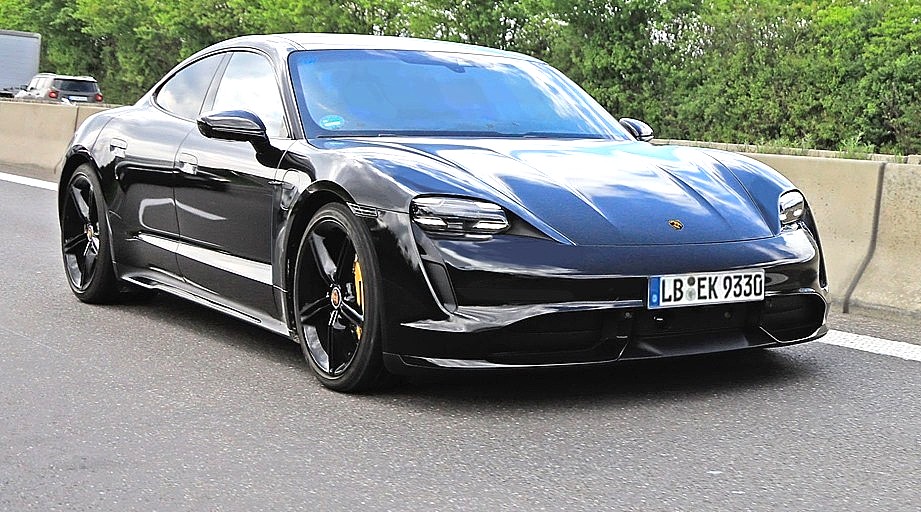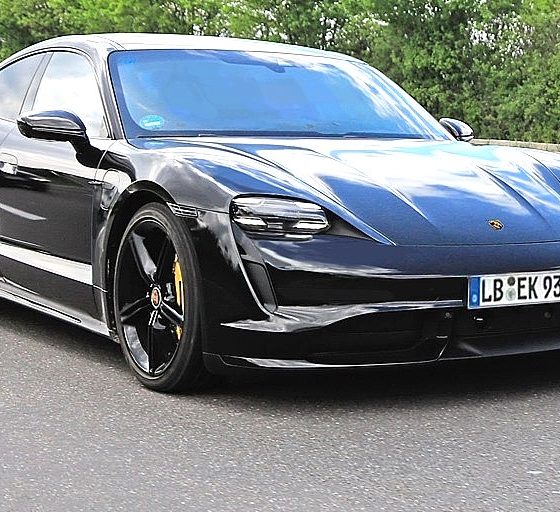

News
Porsche Taycan Turbo first ride teases production specs and price, Turbo S and RWD GTS variant
Porsche recently granted Automobile Magazine a rare test ride in the Taycan Turbo, the top-tier variant of the company’s first modern all-electric car. The test drive provided what could only be described as the closest look yet at the upcoming vehicle, and based on the impressions of the magazine; it appears that the Taycan Turbo could very well become one of Porsche’s most iconic cars yet.
Porsche designed the Taycan with the same principles as its other vehicles. It’s luxurious inside and out, it handles like a sports car, and it is quick — very, very quick. The motoring magazine highlighted this in its test ride, stating that the vehicle has a habit of pushing drivers and passengers back into their seats when it accelerates from 0-60 mph in just over 3 seconds. The publication also noted that the Taycan is more reminiscent of the Porsche 911 than Porsche’s four-door flagship, the Panamera, based on the way the car handled itself despite its weight.
While the Taycan is undeniably impressive, the test ride did raise a particular concern for the vehicle: it’s charging infrastructure, which remains a work in progress. The Taycan could be charged with up to 250 kW at an 800V charge point, but there are only a few charging stations with that output today. Even 400V stations, which can charge the Taycan at around 150 kW, are still relatively few. One can only hope that Porsche can secure the Taycan’s charging infrastructure by the time the vehicle’s production version is unveiled this coming September.

Perhaps most notable from the publication’s test drive were the details of the electric car that were revealed by the carmaker. For one, all Taycans, regardless of trim, are equipped with coated PSCB brakes, though carbon ceramic options are available. Similar to other electric vehicles, the Taycan is capable of regenerative braking as well, though the vehicle’s maximum regeneration is an impressive 250 kW. Higher-tier models also boast features like air suspension and rear-wheel steering.
Porsche is yet to fully announce the final specs of the Taycan, though a brand ambassador has confirmed the contents of a document obtained by the Automobile listing the features and specs of each Taycan version. According to the document, the base Taycan will be Rear Wheel Drive only, and it will be equipped with an 80 kWh battery pack. The base Taycan will be powered by a choice of 240-kW (322-hp) and 280-kW (375-hp) motors, and it will command a price in the low ~$90,000 range.

The vehicle’s mid-range variant, the Taycan 4S, will reportedly be equipped with a 96 kW battery pack and 320-kW (429-hp) or 360-kW (483-hp) electric motors. Pricing for the Taycan 4S will reportedly start in the high ~$90,000 range. The Taycan Turbo, which will be the vehicle’s top-of-the-line version upon its release, will reportedly feature a 96 kWh battery, a 160-kW (215-hp)/221-lb-ft motor up front, and a 300-kW (402-hp)/405-lb-ft motor at the rear. Pricing for the Taycan Turbo is expected to start at ~$140,000.
The Porsche Taycan is expected to be unveiled sometime this coming September, with the company offering the base, 4S, and Turbo versions to customers. At least two other variants of the Taycan will reportedly be unveiled later, one of which is a pretty insane 540-kW (724-hp) Turbo S version and a lighter RWD GTS trim that will most likely be incredibly fun to drive on the track. Porsche is also planning on improving its charging infrastructure in the near future, with peak charging rates for the vehicle increasing from 250 kW to 350 kW by 2021 at the latest.
The Porsche Taycan is arguably one of the most anticipated vehicles in the electric car market this year, particularly as it is one that has the potential to directly challenge the Tesla Model S in the premium EV segment. Porsche is moving full throttle to prepare for the Taycan’s production and ramp, with the company drastically upgrading its Zuffenhausen site to accommodate the manufacturing of the vehicle.

Elon Musk
Elon Musk’s X will start using a Tesla-like software update strategy
The initiative seems designed to accelerate updates to the social media platform, while maintaining maximum transparency.

Elon Musk’s social media platform X will adopt a Tesla-esque approach to software updates for its algorithm.
The initiative seems designed to accelerate updates to the social media platform, while maintaining maximum transparency.
X’s updates to its updates
As per Musk in a post on X, the social media company will be making a new algorithm to determine what organic and advertising posts are recommended to users. These updates would then be repeated every four weeks.
“We will make the new 𝕏 algorithm, including all code used to determine what organic and advertising posts are recommended to users, open source in 7 days. This will be repeated every 4 weeks, with comprehensive developer notes, to help you understand what changed,” Musk wrote in his post.
The initiative somewhat mirrors Tesla’s over-the-air update model, where vehicle software is regularly refined and pushed to users with detailed release notes. This should allow users to better understand the details of X’s every update and foster a healthy feedback loop for the social media platform.
xAI and X
X, formerly Twitter, has been acquired by Elon Musk’s artificial intelligence startup, xAI last year. Since then, xAI has seen a rapid rise in valuation. Following the company’s the company’s upsized $20 billion Series E funding round, estimates now suggest that xAI is worth tens about $230 to $235 billion. That’s several times larger than Tesla when Elon Musk received his controversial 2018 CEO Performance Award.
As per xAI, the Series E funding round attracted a diverse group of investors, including Valor Equity Partners, Stepstone Group, Fidelity Management & Research Company, Qatar Investment Authority, MGX, and Baron Capital Group, among others. Strategic partners NVIDIA and Cisco Investments also continued support for building the world’s largest GPU clusters.
News
Tesla FSD Supervised wins MotorTrend’s Best Driver Assistance Award
The decision marks a notable reversal for the publication from prior years, with judges citing major real-world improvements that pushed Tesla’s latest FSD software ahead of every competing ADAS system.

Tesla’s Full Self-Driving (Supervised) system has been named the best driver-assistance technology on the market, earning top honors at the 2026 MotorTrend Best Tech Awards.
The decision marks a notable reversal for the publication from prior years, with judges citing major real-world improvements that pushed Tesla’s latest FSD software ahead of every competing ADAS system. And it wasn’t even close.
MotorTrend reverses course
MotorTrend awarded Tesla FSD (Supervised) its 2026 Best Tech Driver Assistance title after extensive testing of the latest v14 software. The publication acknowledged that it had previously criticized earlier versions of FSD for erratic behavior and near-miss incidents, ultimately favoring rivals such as GM’s Super Cruise in earlier evaluations.
According to MotorTrend, the newest iteration of FSD resolved many of those shortcomings. Testers said v14 showed far smoother behavior in complex urban scenarios, including unprotected left turns, traffic circles, emergency vehicles, and dense city streets. While the system still requires constant driver supervision, judges concluded that no other advanced driver-assistance system currently matches its breadth of capability.
Unlike rival systems that rely on combinations of cameras, radar, lidar, and mapped highways, Tesla’s FSD operates using a camera-only approach and is capable of driving on city streets, rural roads, and freeways. MotorTrend stated that pure utility, the ability to handle nearly all road types, ultimately separated FSD from competitors like Ford BlueCruise, GM Super Cruise, and BMW’s Highway Assistant.
High cost and high capability
MotorTrend also addressed FSD’s pricing, which remains significantly higher than rival systems. Tesla currently charges $8,000 for a one-time purchase or $99 per month for a subscription, compared with far lower upfront and subscription costs from other automakers. The publication noted that the premium is justified given FSD’s unmatched scope and continuous software evolution.
Safety remained a central focus of the evaluation. While testers reported collision-free operation over thousands of miles, they noted ongoing concerns around FSD’s configurable driving modes, including options that allow aggressive driving and speeds beyond posted limits. MotorTrend emphasized that, like all Level 2 systems, FSD still depends on a fully attentive human driver at all times.
Despite those caveats, the publication concluded that Tesla’s rapid software progress fundamentally reshaped the competitive landscape. For drivers seeking the most capable hands-on driver-assistance system available today, MotorTrend concluded Tesla FSD (Supervised) now stands alone at the top.
News
Elon Musk’s Grokipedia surges to 5.6M articles, almost 79% of English Wikipedia
The explosive growth marks a major milestone for the AI-powered online encyclopedia, which was launched by Elon Musk’s xAI just months ago.

Elon Musk’s Grokipedia has grown to an impressive 5,615,201 articles as of today, closing in on 79% of the English Wikipedia’s current total of 7,119,376 articles.
The explosive growth marks a major milestone for the AI-powered online encyclopedia, which was launched by Elon Musk’s xAI just months ago. Needless to say, it would only be a matter of time before Grokipedia exceeds English Wikipedia in sheer volume.
Grokipedia’s rapid growth
xAI’s vision for Grokipedia emphasizes neutrality, while Grok’s reasoning capabilities allow for fast drafting and fact-checking. When Elon Musk announced the initiative in late September 2025, he noted that Grokipedia would be an improvement to Wikipedia because it would be designed to avoid bias.
At the time, Musk noted that Grokipedia “is a necessary step towards the xAI goal of understanding the Universe.”
Grokipedia was launched in late October, and while xAI was careful to list it only as Version 0.1 at the time, the online encyclopedia immediately earned praise. Wikipedia co-founder Larry Sanger highlighted the project’s innovative approach, noting how it leverages AI to fill knowledge gaps and enable rapid updates. Netizens also observed how Grokipedia tends to present articles in a more objective manner compared to Wikipedia, which is edited by humans.
Elon Musk’s ambitious plans
With 5,615,201 total articles, Grokipedia has now grown to almost 79% of English Wikipedia’s article base. This is incredibly quick, though Grokipedia remains text-only for now. xAI, for its part, has now updated the online encyclopedia’s iteration to v0.2.
Elon Musk has shared bold ideas for Grokipedia, including sending a record of the entire knowledge base to space as part of xAI’s mission to preserve and expand human understanding. At some point, Musk stated that Grokipedia will be renamed to Encyclopedia Galactica, and it will be sent to the cosmos.
“When Grokipedia is good enough (long way to go), we will change the name to Encyclopedia Galactica. It will be an open source distillation of all knowledge, including audio, images and video. Join xAI to help build the sci-fi version of the Library of Alexandria!” Musk wrote, adding in a later post that “Copies will be etched in stone and sent to the Moon, Mars and beyond. This time, it will not be lost.”








